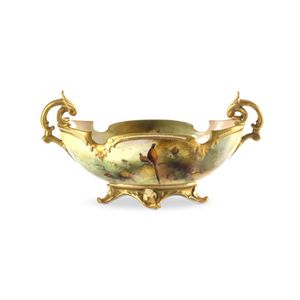Royal Worcester Boat Vase with Roses by R. Austin
You must be a subscriber, and be logged in to view price and dealer details.
Subscribe Now to view actual auction price for this item
When you subscribe, you have the option of setting the currency in which to display prices to $Au, $US, $NZ or Stg.
- Gilding - Gilding is a method of ornamentation whereby a thin sheet of gold metal is applied to items made of wood, leather, ceramics, glass and silver for decorative purposes.
For furniture including mirrors, the sheet of gold is usually applied over a coating of gesso. Gesso is a mixture of plaster of Paris and gypsum mixed with water and then applied to the carved wooden frames of mirrors and picture frames as a base for applying the gold leaf. After numerous coats of gesso have been applied, allowed to dry and then sanded a coat of "bole", a usually red coloured mixture of clay and glue is brushed on and allowed to dry, after which the gold leaf is applied. Over time parts of the gilding will rub off so the base colour can be seen. In water gilding, this was generally a blue colour, while in oil gilding, the under layer was often yellow. In Victorian times, gilders frequently used red as a pigment beneath the gold leaf.
Metal was often gilded by a process known as fire gilding. Gold mixed with mercury was applied and heated, causing the mercury to evaporate, the long-term effect of which was to kill or disable the craftsman or woman from mercury poisoning. The pursuit of beauty has claimed many victims, not the least of which were the artists who made those pieces so highly sought after today. - Edwardian - The Edwardian period of English furniture and decorative arts design is named for Edward VII (1841 ? 1910) who was King of the United Kingdom and the British Dominions and Emperor of India for the brief period from 1901 until his death in 1910. It follows the Victorian period, in turn was followed by the Art Nouveau and Art Deco styles. In Australia, designs of this period are also known as being in the Federation style.
This item has been included into following indexes:
Visually similar items

Royal Worcester posy vase boat shaped painted with roses, signed R Ashton, 26 cm length

A Royal Worcester dish by Reginald Austin, dated 1930, of shallow boat shaped form painted with pheasants sitting on pine branches, within beaded gilt borders flanked by acanthus capped scrolling gilt handles, 24 cm across the handles, puce factory mark, s

A Carlton Ware 'Paradise Bird' bell gondola vase, third quarter 20th century, unidentified decoration pattern (reissue) both sides painted with a single flying bird and butterflies around Chinese-style flowering shrubbery, a variant of the 'Paradise bird'

A Royal Worcester bon bon dish gilt encrusted and with hand painted rose decoration date approx. 1912 probaby hand painted by Harry Stinson. 254H 15-54. Length 25 cm
